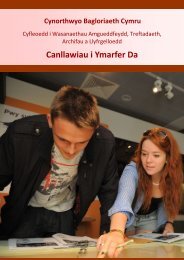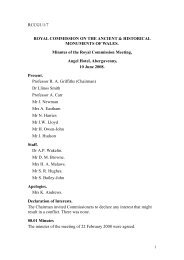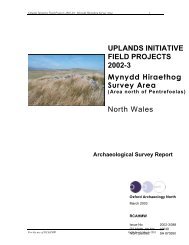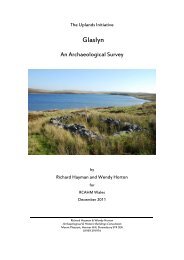Upl<strong>and</strong>s Initiative – Nant y Moch & Pumlim<strong>on</strong> Fawr / <str<strong>on</strong>g>Plynlim<strong>on</strong></str<strong>on</strong>g> 2004agree with W.G. Hoskins <strong>the</strong> l<strong>and</strong>scape historian, that ab<strong>and</strong><strong>on</strong>ed metal mines are 'perhaps <strong>the</strong> mostappealing of all <strong>the</strong> industrial l<strong>and</strong>scapes ... in no way ugly but indeed possessing a profoundmelancholy beauty'. Unlike <strong>the</strong> medieval castle with its overt<strong>on</strong>es of bloodshed <strong>and</strong> war, <strong>the</strong>se sitesof h<strong>on</strong>est endeavour as yet have few protag<strong>on</strong>ists. They have been badly mauled <strong>and</strong> evendestroyed in recent years regardless of archaeological merit, especially in forestry areas under <strong>the</strong>heading 'removing <strong>the</strong> scars of industry', <strong>and</strong> until <strong>the</strong> climate changes <strong>the</strong> industrial archaeologisthas urgent tasks before him.For <strong>the</strong> most part <strong>the</strong> old mines of West M<strong>on</strong>tgomeryshire are lost within a l<strong>and</strong> of rough tracks <strong>and</strong>hea<strong>the</strong>r, a l<strong>and</strong> more suited to <strong>the</strong> pedestrian than <strong>the</strong> motorist. But in any event our motives <strong>and</strong> not<strong>the</strong> state of <strong>the</strong> roads should determine our transport. If we wish to gain a closer kinship with <strong>the</strong>Old Men — in a sense to step into <strong>the</strong>ir shoes, — surely we must walk <strong>the</strong>re, treading <strong>the</strong> old pathswith <strong>the</strong> old winds in our faces. We lose a little time but we gain admissi<strong>on</strong> into ano<strong>the</strong>r world‖(BICK 1991, p5)On <strong>the</strong> immediate east side of <str<strong>on</strong>g>Plynlim<strong>on</strong></str<strong>on</strong>g> are what Bick has termed <strong>the</strong> Wye Valley mines. These he hasdivided into those west of <strong>the</strong> river <strong>and</strong> those <strong>on</strong> <strong>the</strong> east. Those that c<strong>on</strong>cern us here are <strong>the</strong> ‗Wye LeadNing Company‘ 1868-72, <strong>the</strong> ‗West Wye Valley Mine‘ 1875-80, <strong>the</strong> ‗Wye Valley‘ 1874-79, <strong>the</strong> ‗New WyeValley‘ 1879-82 <strong>and</strong> <strong>the</strong> ‗Wye Mine Ltd‘ 1883-85.―We shall deal first with <strong>the</strong> eastern mine, <strong>the</strong> better of <strong>the</strong> two <strong>and</strong> sometimes known asNantygwrdy after a tributary of <strong>the</strong> Wye. W.W. Smyth reported a great width of veinst<strong>on</strong>e at <strong>the</strong>spot <strong>and</strong> about <strong>the</strong> same time (1846) Mat<strong>the</strong>w Francis expressed 'a good opini<strong>on</strong> of Nanty Gwrdu, itis an excellent lode'. These remarks ra<strong>the</strong>r suggest that little or nothing had <strong>the</strong>n been d<strong>on</strong>e.In July 1863 John Taylor & S<strong>on</strong>s were managing operati<strong>on</strong>s which c<strong>on</strong>sisted of sinking an engineshaft, driving an adit crosscut to <strong>the</strong> lode <strong>and</strong> preparing for a 30 ft wheel. By 1866 five stopes over<strong>the</strong> adit were yielding ore but <strong>the</strong> lode in <strong>the</strong> 10 fathom level was described as 'much disordered bya very powerful crosscourse of hard spar'. The mine came up for sale toge<strong>the</strong>r with Nanty in 1867,having reached a 34 fathom level under <strong>the</strong> adit, or 52 fathoms from surface.An attempted revival took place in May 1874 by a company styling itself North Van Mines Ltd,with <strong>the</strong> peculiar objective of combining <strong>the</strong> works with a worthless trial near Trefeglwys.A few m<strong>on</strong>ths later <strong>the</strong> Wye Valley Company was formed with Messrs. Ross <strong>and</strong> Kitto am<strong>on</strong>g <strong>the</strong>management. Aided by Captain Walter Eddy's statement that <strong>the</strong> mine was <strong>on</strong> <strong>the</strong> Van lode <strong>and</strong>Kitto's asserti<strong>on</strong> that <strong>the</strong> machinery <strong>on</strong>ly needed 'trifling repairs to put it in thorough workingc<strong>on</strong>diti<strong>on</strong>' sufficient capital was raised to commence. Taylors had missed some good ore, for almostat <strong>on</strong>ce <strong>the</strong> adit provided 30 t<strong>on</strong>s of lead ore m<strong>on</strong>thly <strong>and</strong> 10% dividends were so<strong>on</strong> being paid. Inplaces <strong>the</strong> lode measured 10 fathoms wide, making extensive cross-cutting necessary to avoidmissing ore. Patent self-acting dressing machinery was installed <strong>and</strong> a new shaft sunk to <strong>the</strong> east. In1876 a winze sinking below <strong>the</strong> 10 ran into a splendid run of ore worth 5 t<strong>on</strong>s/fathom, but <strong>the</strong>reafterfortunes declined <strong>and</strong> <strong>the</strong> company dissolved in 1879. However, mining c<strong>on</strong>tinued under <strong>the</strong>optimistic Kitto <strong>and</strong> his s<strong>on</strong>, <strong>and</strong> <strong>the</strong> new shaft complete with skip road was sunk to a 46 fathomlevel. Unfortunately <strong>the</strong> lode although 'masterly <strong>and</strong> promising' showed very little ore, <strong>and</strong> afterdeeper levels brought no improvement <strong>the</strong> mine finally faded away in <strong>the</strong> mid 1880's. Altoge<strong>the</strong>r,<strong>the</strong> returns came to 1904 t<strong>on</strong>s of lead ore <strong>and</strong> 446 t<strong>on</strong>s of blende.We now cross <strong>the</strong> river to where <strong>the</strong> Wye Lead Mining Company commenced its work in 1868.This c<strong>on</strong>cern was a child of <strong>the</strong> formidable company secretary <strong>and</strong> promoter of lead mines, JohnHenry Murchis<strong>on</strong>. An adit represented <strong>the</strong> sum total of earlier trials but under Captain John Paull anengine shaft bearing Murchis<strong>on</strong>'s name was so<strong>on</strong> sinking by six men. A 40 ft waterwheel forpumping <strong>and</strong> drawing went to work in 1869, powered by a mile-l<strong>on</strong>g leat from <strong>the</strong> Cyff Brook, <strong>and</strong>by <strong>the</strong> end of <strong>the</strong> year six men were cross-cutting from Murchis<strong>on</strong>'s Shaft to <strong>the</strong> lode for a 14fathom level, 22 fathoms from surface.Early in 1872 a 40 fathom level had been attained but with very little ore in sight. Murchis<strong>on</strong><strong>the</strong>reup<strong>on</strong> attempted a rec<strong>on</strong>structi<strong>on</strong> under <strong>the</strong> alluring title of New Van, but work so<strong>on</strong> ceased dueto lack of support.71CAP Report No: 355
Upl<strong>and</strong>s Initiative – Nant y Moch & Pumlim<strong>on</strong> Fawr / <str<strong>on</strong>g>Plynlim<strong>on</strong></str<strong>on</strong>g> 2004Operati<strong>on</strong>s did not revive until Kitto & Co., encouraged by <strong>the</strong>ir success across <strong>the</strong> river, formed<strong>the</strong> West Wye Valley Lead Mining Company in 1875. To test <strong>the</strong> ground nearer Wye Valley,Brooke's Shaft was sunk 77 fathoms east of Murchis<strong>on</strong>'s <strong>and</strong> in December 1876 Kitto reported itsdepth as 25% fathoms. Both <strong>the</strong> 14 <strong>and</strong> 26 fathom levels driving east from Murchis<strong>on</strong>'s were ingood ore <strong>and</strong> <strong>on</strong> surface dressing floors had been laid out <strong>and</strong> a new water-wheel erected forpumping, drawing <strong>and</strong> running a sawmill. A 30 ft wheel worked a crusher <strong>and</strong> nearly completedwere 'four very good miner's cottages, which will supply sleeping accommodati<strong>on</strong> for 32 menbesides <strong>the</strong> occupiers.Early in 1878 Brooke's Shaft was sinking under <strong>the</strong> 40 but as at Wye Valley <strong>the</strong> lode failed indepth. Mining ceased in 1880 after yielding <strong>on</strong>ly 360 t<strong>on</strong>s of lead ore.Not much remains of <strong>the</strong> Wye Valley mines. The western workings are partly submerged in trees<strong>and</strong> <strong>the</strong> dressing floors <strong>on</strong> <strong>the</strong> east side are occupied by farm buildings. There is however, in <strong>the</strong>little ravine of Nantygwrdy a very fine lode (probably a branch) of breccia <strong>and</strong> brown sugary quartzno doubt just as W.W. Smyth saw it, that revealed a splendid st<strong>on</strong>e of galena to me, as a youthfulexplorer many years ago.Higher up <strong>the</strong> valley 1500 ft above sea level is NANTIAGO (SN 826863) - a mine which may besaid to epitomise all those minor workings in <strong>the</strong> wildest parts of Wales that struggled <strong>on</strong> forgenerati<strong>on</strong>s, rarely paying cost <strong>and</strong> always in hopes of better times to come. In its early daysNantiago was known as Plynlimm<strong>on</strong>, <strong>and</strong> mining had barely started when Mat<strong>the</strong>w Francisexamined <strong>the</strong> property in 1846 for <strong>the</strong> lessee Robert Parry. As to <strong>the</strong> machinery Francis did notmince his words.‗Nothing can be more absurd than <strong>the</strong> idea of erecting a 12 feet water-wheel 2 feet Breast <strong>and</strong>attaching Pitwork crushing <strong>and</strong> dressing Machinery to it, it is like harnessing a Mouse to a BrewersDray <strong>and</strong> I would advise you to lay in a Capital of £4000 or £5000. Erect in <strong>the</strong> first place a goodthirty feet wheel with 3 feet Breast, attach a good crushing mill to it as well as your pump power<strong>and</strong> erect a 25 ft wheel for drawing <strong>the</strong> stuff.‘This advice, sound though it was, probably sufficed to finish <strong>the</strong> attempt, but <strong>the</strong> following report of1853 shows that <strong>the</strong> mine was in work again before l<strong>on</strong>g. It also reveals something of <strong>the</strong> harshphysical envir<strong>on</strong>ment.This venture also failed, but work revived early in 1860 when <strong>the</strong> engine shaft was 5 fathoms belowadit in a lode '5 ft wide composed of mundic, prian, lead <strong>and</strong> blende producing 4 t<strong>on</strong>s of <strong>the</strong> latterper fathom'. A waterwheel was brought from Esgairlle <strong>and</strong> James Roach became manager in 1861.A 30 fathom level was reached in 1863 but <strong>the</strong> mine came <strong>on</strong> <strong>the</strong> market with all <strong>the</strong> machinery for<strong>on</strong>ly £500 in March 1865.By 1872 William Lefeaux who had earlier realized a fortune at Penyclun, was a director <strong>and</strong> heremained involved for many years, eventually dying penniless at <strong>the</strong> mine. A new 60 ft wheelcommenced pumping in 1873 <strong>and</strong> subsequently ore was raised almost without intermissi<strong>on</strong> up to1888 after which all work seems to have ceased until formati<strong>on</strong> of a new company about 1900.John Mills & Co. of Uanidloes Foundry erected a new 56 ft pumping wheel (normal speed 3 RPM)<strong>and</strong> an extensive dressing plant three stories high <strong>and</strong> powered by two Pelt<strong>on</strong> Wheels was built withst<strong>on</strong>e breaker, rolls, trommels <strong>and</strong> six 4-compartment jigs.Twelve men worked underground <strong>and</strong> four above in 1905, <strong>and</strong> a glimpse of life at Nantiago aboutthis time was given to me l<strong>on</strong>g afterwards by <strong>the</strong> head dresser, Mr.Pliilpot. He cycled <strong>the</strong>re everyM<strong>on</strong>day from his home near Shrewsbury for a 9 a.m. start <strong>and</strong> lived in barracks during <strong>the</strong> week.Normal hours were 7 a.m. - 4.30 p.m. in winter <strong>and</strong> 6 a.m. - 3.30 p.m. in summer. Philpot was agreat advocate of water power which he c<strong>on</strong>sidered 'better than steam' provided <strong>the</strong>re were nodelays from frost or drought. For such emergencies <strong>the</strong> managing director Arthur Onslow installeda Crossley gas engine to assist <strong>the</strong> pumping wheel. Philpot's wages were 30/- per week.Will Richards worked at Nantiago during <strong>the</strong> Great War <strong>and</strong> he has written a vivid impressi<strong>on</strong> of aworld of gunpowder, kibbles <strong>and</strong> c<strong>and</strong>les, still within a lifetime's span <strong>and</strong> yet whole worlds away.He records <strong>the</strong> carrier Robert Ingram driving a cart <strong>and</strong> two horses from Llanidloes every M<strong>on</strong>day71CAP Report No: 355




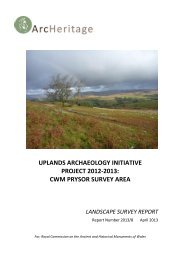
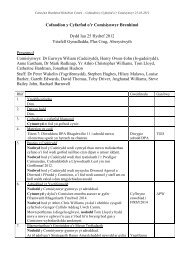



![The Source of the Usk Walk [2012 PDF]](https://img.yumpu.com/49285699/1/190x245/the-source-of-the-usk-walk-2012-pdf.jpg?quality=85)

